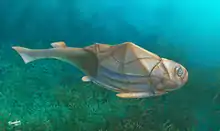| Parayunnanolepis Temporal range: Early Devonian, | |
|---|---|
 | |
| Artist's reconstruction | |
| Scientific classification | |
| Domain: | Eukaryota |
| Kingdom: | Animalia |
| Phylum: | Chordata |
| Class: | †Placodermi |
| Order: | †Antiarchi |
| Family: | †Yunnanolepididae |
| Genus: | †Parayunnanolepis |
| Species: | †P. xitunensis |
| Binomial name | |
| †Parayunnanolepis xitunensis Tong-Dzuy & Janvier 1990 | |
Parayunnanolepis xitunensis is an extinct, primitive antiarch placoderm. The fossil specimens, including a marvelously preserved, intact specimen, are known from the Lochkovian Epoch-aged Xitun Formation of Early Devonian Yunnan. The armor is very similar to that of Yunnanolepis, but is distinguished by being comparatively more flattened.
An intact and exquisitely preserved specimen demonstrates that the living animal had pelvic fins and a pelvic girdle, thus proving that antiarchs had, primitively at least, pelvic girdles, and or inherited them from a common ancestor of both placoderms and other gnathostomes.[1][2]
References
- ↑ "New study showing pelvic girdles arose before the origin of movable jaws". phys.org. 10 Jan 2012. Retrieved 31 December 2019.
- ↑ Zhu, Min; Yu, Xiaobo (4 Jan 2012). "An antiarch placoderm shows that pelvic girdles arose at the root of jawed vertebrates". Royal Society Biology Letters. Retrieved 31 December 2019.
This article is issued from Wikipedia. The text is licensed under Creative Commons - Attribution - Sharealike. Additional terms may apply for the media files.
